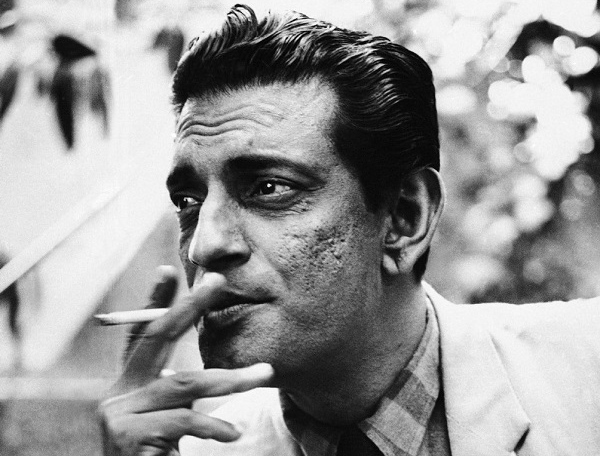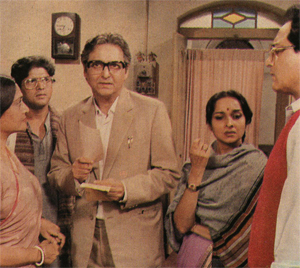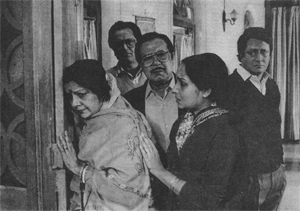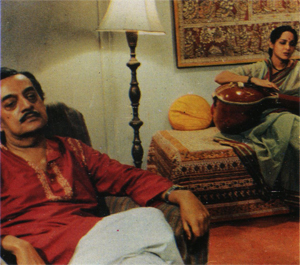THE SINS OF A PIONEERSatyajit Ray Re-Examined – part two
Ray's best adaptations from his own stories are films like Goopy Gyne Bagha Byne and Sonar Kella which are essentially for children, although Ray's humour and virtuoso storytelling ability make them enjoyable at any age. Until he completed Shatranj Ke Khiladi Ray seems to have successfully avoided uncertain terrain and, for all their flaws, his films upto (and including) Shatranj are marked by gentleness and humour. The trouble, I think, really began with Ghare Bhaire. From this film onwards we begin to feel that as a great filmmaker, Ray was conscious that 'statements' were expected from him. The change in attitude towards his own work and its importance is also evidenced by his later adaptation of an early story. Among the stories in the collection I mentioned earlier is one entitled 'The Guest'. This story, like the others in the collection, is lightweight and gives us no reason to suspect that it could be adapted as ponderously as it was in 1991. Agantuk is Ray's adaptation of 'The Guest' after he became convinced of the importance of his own ethical vision. Agantuk is the last part of Ray's final trilogy but before we examine Ray's ethical vision as evidenced in his final films, it may perhaps be worthwhile to take a cursory look at what ethics can mean in narrative cinema. Artists have long debated over the place of ethics in their work. With the rise of Marxism as an intellectul force, Lenin's dictum that 'Ethics are the aesthetics of the future’ reinforced the belief that ethics was all-important in art. Marxism as a dogma also provided the 'committed' artist with a readymade framework within which individual actions might be judged. While some filmmakers (from Sergei Eisenstein to Gillo Pontecorvo) who were primarily not taken up with the status of the individual, were content with the broad ethical framework provided by Marxist orthodoxy, others (Jean Renoir, Jean-Luc Godard) whose work reflected the predicament in which the individual was placed, went deeper to understand the difficulties involved in making lasting judgements, the manner in which the differences between good and evil have become less distinct. In Renoir's La Chienne the essentially decent hero brutally murders his mistress and allows an innocent man to die for the act. The man who is executed is a thief and a pimp who still does not deserve to die. Godard's early films seem to be poised in the act of making a political choice between two sides which are not unlike in their methods (Le Petit Soldat, La Chinoise). Godard, like Bertold Brecht (in 'The Measures Taken') consciously chooses 'the boring pamphlet and the necessary murder' as alternatives to inaction. The fall of the Marxist state has made the ethical question in art an even more difficult one. In any case, one can say that the deeper ethical questions can only be answered if one accepts the darker aspects of one's drives and emotions. A sensibility which refuses to come to terms with these darker aspects might have all its enquiries condemned to remain superficial.
After Ganashatru Ray made two more films in the same mould, both of them based on his own stories. Shakha Proshakha, the first of these two films, relates a story set during the seventieth birthday celebrations of Ananda Majumdar, a businessman and a philanthrophist who rose from humble origins to become the owner of a Mica producing firm and the patriarchal figure in a town which now bears his name – Anandanagar. Ananda has four sons and three of them now live in Calcutta. The second son, once the most 'brilliant' of the four is now robbed of his mental faculties because of an unfortunate automobile accident. This son now lives with his father, doing nothing between fits of melancholia except listen to music.
There are several sub-plots in the film but this brief narration is enough for the reader to understand how ludicrous Ray's moral perspective seems. Shakha Proshakha is told chiefly from Ananda's view point and Ananda remains its moral centre. Ananda is blameless but doesn't Ray understand how impossible it is for us to accept a prosperous businessman as a figure of moral authority? When Ananda's youngest son sacrifices his job, one tends to remember the fortune which is coming to him from his father and this makes us doubt the value of his sacriflce. Ray was an avid reader of detective fiction. One wonders if he couldn't have read Dashiel Hammett's 'Red Harvest' which describes a small industrial town in the grip of a single economic interest, a small town which is a far cry from Ray's 'Anandanagar'. Shakha Proshakha fails abysmally as a moral statement and this is largely due to Ray's chronic inability to understand the darker aspects of human behaviour in the context of which moral questions become so much more complex. 'Behind every great fortune is a crime' wrote salzac. By making Ananda rise from the ranks of an ordinary worker to the status of a successful capitalist through completely unimpeachable means, Ray shows more faith in the intrinsic merit of capitalism than seemed reasonable even in Balzac's time. After Shakha Proshakha came Agantuk. The hero and heroine of this film are visited by a maternal uncle of the latter, whom neither of them has ever seen. Manmohan Mitra left home at an early age and no one knows what he has been upto for the past thirty-five years, after he reportedly went abroad. The film follows the story ('The Guest') quite closely in the beginning – the couple is naturally suspicious because the man who is visiting them could be an imposter. After the gentleman actually arrives they discover how unjust their suspicions really are. But this happens a little too late because the uncle has left, also leaving behind some money for his niece.
Satyajit Ray received the greatest amount of international acclaim long after his best films were made. Ray was not indifferent to the acclaim and this may have caused him to place an entirely wrong emphasis on the importance of his work. About Charles Chaplin it was once said (by Eric Bentley) that he put into his later films what people said they found in his early ones. Satyajit Ray was a master storyteller. The acclaim he received in the last decade of his life may have persuaded him that he needed to be much more than a storyteller to merit the acclaim. That may have been the real tragedy of his last few films. M.K. Raghavendra [in "Deep Focus", VI, 1996, pp. 39-46]
Films di Satyajit Ray citati nel testo (in parentesi, oltre alla traslitterazione e alle date, vengono riportati anche i titoli inglesi con cui i film sono conosciuti) Agantuk (Āgantuk ; The Stranger, 1991) Nota |
a cura di Cecilia Cossio




